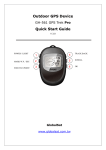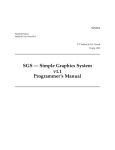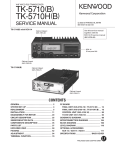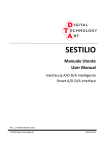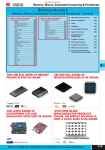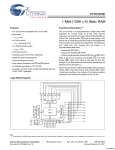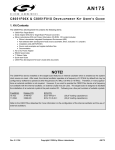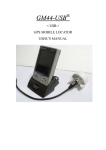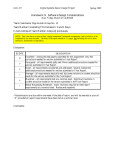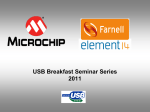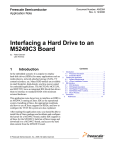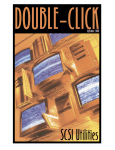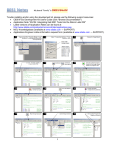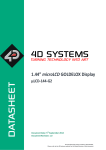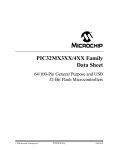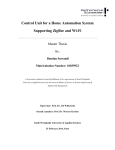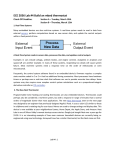Download Homework 3: Design Constraint Analysis and Component Selection
Transcript
ECE 477 Digital Systems Senior Design Project Spring 2009 Homework 3: Design Constraint Analysis and Component Selection Rationale Due: Friday, February 6, at NOON Team Code Name: Digi-iGuide Group No. 11 Team Member Completing This Homework: Greg Ross E-mail Address of Team Member: [email protected] NOTE: This is the first in a series of four “professional component” homework assignments, each of which is to be completed by one team member. The body of the report should be 3-5 pages, not including this cover page, references, attachments or appendices. Evaluation: SCORE 10 9 8 7 6 * DESCRIPTION Excellent – among the best papers submitted for this assignment. Very few corrections needed for version submitted in Final Report. Very good – all requirements aptly met. Minor additions/corrections needed for version submitted in Final Report. Good – all requirements considered and addressed. Several noteworthy additions/corrections needed for version submitted in Final Report. Average – all requirements basically met, but some revisions in content should be made for the version submitted in the Final Report. Marginal – all requirements met at a nominal level. Significant revisions in content should be made for the version submitted in the Final Report. Below the passing threshold – major revisions required to meet report requirements at a nominal level. Revise and resubmit. * Resubmissions are due within one week of the date of return, and will be awarded a score of “6” provided all report requirements have been met at a nominal level. Comments: Comments from the grader will be inserted here. ECE 477 Digital Systems Senior Design Project Spring 2009 Section 1 - Introduction The basic functionality would have the user input a destination and the device will determine the user’s current position with a GPS module, and calculate the shortest path. The device will display this information to the user on an LCD screen as a map overlaid with the path. The device will also provide the user with information about points of interest. The features that will cause design constraints include the graphics, the GPS, and the calculation of the user’s path to the destination. Section 2 – Design Constraint Analysis The major design constraints that will be considered are the computational and interfacing requirements. We are implementing a shortest path algorithm, and we’ll need to store a significant amount of information in memory, so our MCU will need to have solid computing capabilities. Section 2.1 – Computation Requirements The software for the Digi-iGuide will be computationally demanding both from the memory and operating speed standpoints. We will compute the shortest path to the user’s destination using a graph data structure, and if we assume a worst case scenario where we keep track of the graph’s edges in a table (2-D array), we will need to store one 8-bit value for each possible edge (even unconnected edges). If we have 150 nodes in our graph, this would be about 23 KB of data in memory. This again is a worst-case scenario, and we plan on storing edges in a much more efficient linked-list implementation, but we would still like to have a very large amount of onchip memory. We also anticipate that operational speed will need to be as high as possible due to the large software computations, however since we do not have to consider issues such as minimum sampling frequencies; we have no hard numbers for processor speed. Section 2.2 – Interface Requirements The Digi-iGuide’s only method of interfacing with the user is though an LCD Touch Screen device. As a handheld device, the most appropriate screen size will be between 3” and 4” with a resolution at or around 320 x 240 pixels. During the parts search, two components were located that could suit the needs of the project. One 4.3” touch screen from Newhaven had a 480 x 272 -2- ECE 477 Digital Systems Senior Design Project Spring 2009 pixel touch screen and required a parallel LVDS (low voltage differential signal) interface that would constantly refresh the screen at a frequency of 60Hz. This component had no graphics controller included, and recommended the use of a graphics controller that was no longer being manufactured [1]. The other component was a 3.2” touch screen from 4D Systems that came with a 320 x 240 pixel touch screen integrated with a proprietary graphics controller. The graphics controller has built in functionality to interface with a FAT16 formatted micro-SD cards, read and output WAV audio files, transmit graphical data to the LCD, as well as read back and decode the touch screen data. The 4D System unit included the touch screen, graphics controller, micro-SD slot, on-board speaker, and a UART connection all in one PCB package [2]. If the final design included the Newhaven display, a graphics controller would (most likely) have to be implemented in an FPGA which would significantly decrease the feasibility of the project. The 4D System LCD unit (Part No: LCD-32032-P1T) included many useful features, but the documentation recommends the use of a high speed UART operating at 512K-baud or 1M-baud [2]. The team made the decision that the 4D System part was much better for the project needs, though it did introduce a major constraint on processor selection and cost nearly twice as much as the Newhaven display. The main processor must either have an on-board high speed UART, or be electrically fast enough to allow software emulation of a 1M-baud UART by toggling output pins. The LCD-32032-P1T can interface with another microprocessor through a 3.3V CMOS UART with baud rates ranging from 4800 baud to 1M-baud. For any input signal to be registered as a logic low (including the UART pins) the maximum voltage must not exceed 0.7V, and the minimum input high voltage is 2.6V. Output pins guarantee a maximum output low voltage of 0.4V and a minimum output high voltage of 2.6V [2]. The Digi-iGuide needs to be able to track the user’s location, thus a GPS unit is required. Previous teams that utilized GPS technology were able to easily interface with the GlobalSat EM-406a GPS receiver that utilizes a standard 4800 baud UART. The amount of data available for this chip is limited, but GlobalSat’s specification sheet identifies the UART as utilizing TTL logic levels. Maximum logic low voltage levels nor minimum logic high voltage levels are -3- ECE 477 Digital Systems Senior Design Project Spring 2009 available for either the RX or TX lines of the UART. However, various portions of the specification sheet hint that the TTL output logic levels are around 0V (low) and 2.85V (high) and the inputs are 3.5V tolerant [3]. Finally, the user and developers need a way to re-program the device to support new maps or updated maps. This will be done via an external USB port that must be connected either to the microprocessor’s USB I/O or connected to a peripheral chip that provides USB functionality. Based on the experience of some team members, the Silicon Laboratory’s C8051F320 USB MCU will be placed on the PCB board to provide an off-chip USB port. The C8051F320 can communicate with the main microprocessor via an SPI bus. The C8051F320 has tentatively been identified to support 3.3V CMOS logic interfaces that are 5V tolerant, but no additional documentation on voltage and current requirements are available in the data sheet. The C8051F320 also has enough spare pins that it could also function as an SPI based port expansion module if the need arises [4, 5]. Section 2.3 – On-Chip Peripheral Requirements Our design requires the use of a relatively large number of on-chip peripherals. The GPS module requires a standard UART while the LCD module requires a high speed UART. A background debug UART is not required given the JTAG interface is available for debugging, but the GPS UART’s RX line (TX from the microprocessor’s point of view) could be used as an output-only debug UART if needed. A minimum of two UARTs are required, with three being preferred. Since we will be storing large image files and look-up-tables, the microprocessor needs additional off-chip flash memory. To minimize the pin requirements, the SPI bus already needed for the C8051F320 will be utilized along with a few GPIOs for slave select lines. If external memory is needed for the software algorithms being implemented on the device, a parallel SRAM or SDRAM interface would also be preferred on the main microprocessor and would use up approximately 30 I/O pins. Section 2.4 – Off-Chip Peripheral Requirements -4- Digital Systems Senior Design Project ECE 477 Spring 2009 As previously mentioned, flash storage will be required in order to store the massive amounts of data needed by the device. The largest flash chips with an SPI bus that are available have an upper capacity limit of 64Mbit [6], and the team’s first assessment indicates that at least 8090Mbit of flash storage will be needed. So the device will require no less than two SPI flash modules each with individual capacities of 64Mbit or more. The GPS UART must be compatible with TTL logic, which may require a small amount of circuitry to interface with the main microprocessor if the UART is actually a CMOS family interface. Likewise, the LCD UART is CMOS based and might require supporting circuitry if the UART pins are of the TTL logic family. Due to the complexity of the software algorithms being implemented on the device, it is possible that external SRAM will be required. Given that there is no known requirement yet for SRAM capacity, the larger the chip the better but at the same time must use as few pins as possible while being reasonably fast. An evaluation on the available I/O pins on every microprocessor being considered indicates that there are not enough pins available to interface with the microprocessor direction, and the C8051F320 will have to be used to provide port expansion as well. Section 2.5 – Power Constraints Part Voltage (Min, Max) Max Current Draw SRAM CY7C1049DV33 [7] 3.0V, 3.6V 80mA Flash W25X64VZEIG [6] 2.7V, 3.6V 25mA PIC32MX440F512H [8] 2.3V, 3.6V 75mA C8051F320 [5] 2.7V, 5.25V 18mA GlobalSat EM-406A GPS [3] 4.5V, 6.5V 60mA LCD-32032-P1T [2] 4.5V, 5.5V 100mA Table 2.2.1 – Summary of Datasheet Power Specifications Based on a summary of the datasheets in the table shown above a 3.3V power rail will be used to supply power to the SRAM, 2 flash chips, main microcontroller and the USB peripheral -5- ECE 477 Digital Systems Senior Design Project Spring 2009 microcontroller. A 5V power rail is required to power the GPS module and the LCD screen. Since the nominal voltage for the battery suggested by the course staff (UBBP01) is 3.7V [9], one regulator is required to step-down the power to 3.3V and another regulator system is required to step-up the 3.7V input to 5V. In total about 205 mA will be drawn from the 3.3V power rail and 160mA from the 5V rail. The battery has a capacity of 1800mA hours, which should provide about 5 hours of battery life. Since the battery requires at least 180mA current to charge and one USB port can supply 500mA, we cannot power the device and the charge the battery at the same time [9]. Either portions of the device will have to be selectively shut off when charging the battery or a wall wart solution will be required. Section 2.6 – Packaging Constraints The device needs to be small enough to carry and comfortable enough to hold. The material of choice for the packaging will most likely be molded plastic since it is light weight has no effect on the GPS signal, unlike metallic material like aluminum. The device should be tough enough to withstand a fall from eye-level, but still not bulky. Section 2.7 – Cost Constraints The biggest cost constraint will be the LCD screen, which optimally will support touch. The LCD screens that would suit our desires are around $200, however we 4D Systems is willing to sample this part for us, so we do not anticipate having to pay for it. Our only other significant expenses are the GPS module and possibly a development board. The GPS units we have looked at range from $50 to $100, and a development board would cost around $50. While not necessary, we see the development board as the best way to get an early start on our project. There are currently no devices that fill our market niche, however our product is similar in nature to a device such as a Tomtom One 130S, which has a MSRP of $199. -6- Digital Systems Senior Design Project ECE 477 Spring 2009 Section 3.0 – Component Selection Rationale Our first major component comparison is our MCU. We will consider two processors, the PIC32MX440F512, and the Freescale MCF5249. The major decision categories are listed in the table below, along with the performance metrics for each chip. We are choosing a chip with a “worst case scenario” mindset, which is to say that in the worst case scenario we may need to use a RAM interface, so we prefer a chip that allows us to do so. Metric PIC32MX440F512 [8] Freescale MCF5249 [10] Frequency 80 MHz 120 MHz Package 64-TQFP 144-QFP On-board FLASH 512 KB None On-board RAM 32 KB 96 KB RAM Interface SRAMz SDRAM High-Speed UART 1 @ speeds up to 20 Mbit None Total UARTs 2 2 Total SPI 1 1 USB Interface Yes None Debug Interface JTAG JTAG Development Tools Familiar to our group Unfamiliar to our group While it is possible that we may not end up needing to use all of the chip’s features, for example we may not need all 512 KB of onboard flash, we would strongly prefer to have the option available. With this in mind the PIC32 appears to be the best choice for an MCU. In addition to the MCU, our LCD display will be a major component. Our LCD was not nearly as close of a comparison, since we were unable to find very many displays that fit our needs. -7- Digital Systems Senior Design Project ECE 477 Metric µLCD-32032-P1T [2] Spring 2009 NHD Series LCD TFT [1] Pixel Resolution 320 X 240 480 X 272 Touch Support Yes No Integrated Controller Yes No Cost Free (by Sample) $79.90 The µLCD-32032 is the clear winner. The potential downside is if a part of the display package is broken during development, it could cost more to replace, however the replacement may still be less than the $80 pricetag of the NHD Series. Our final major component consideration is the GPS module. All of the modules we looked at used the NMEA protocol for communication via a UART, so our selection criteria were narrowed down to price and familiarity. We will use the GlobalSat module for cost efficiency. Metric GlobalSat EM-406a [3] ETEK EB-85a [11] Familiarity Used by B.E.A.R.S. team Used by Global Pigeon Team Cost $60 $90 Section 4.0 – Summary As mentioned previously, our approach to component selection is to find components that give us as many options as possible. We chose an MCU that will give us a great deal of flexibility in implementation and has solid development tools for debugging and quick start-up. Our LCD display has a build-in controller that will free-up MCU resources for other processing tasks. The GPS module we have chosen is both relatively low cost, and it uses the industry standard NMEA communications protocol. -8- ECE 477 Digital Systems Senior Design Project Spring 2009 List of References [1] NHD-4.3-480272YF-ATXI#-1 LCM (Liquid Crystal Display Module), rev. 003, Newhaven Display, Elgin, IL, 2008 [2] LCD-32032-P1T USERS MANUAL, rev. 1.1, 4D Systems, Redwood City, CA, 2008 [3] EM-406a GPS RECEIVER ENGINE BOARD, rev. 1.1, GlobalSat, Taipei, Taiwan, 2006 [4] C8051F320 DATA SHORT, Silicon Labs, Austin, TX, 2006 [5] C8051F32x DATA SHEET, rev. 1.3, Silicon Labs, Austin, TX, 2008 [6] WINBOND SPI FLASH, rev. I, Winbond, Taipei, Taiwan, 2008 [7] CY7C1049DV33, rev. D, Cypress Semiconductor Corp, San Josa, CA, 2007 [8] PIC32MX3XX/4XX Family Data Sheet, rev. E, Microchip, Tempe, AZ, 2008 [9] UBBP01 TECHNICAL DATASHEET, rev. D, Ultralife Batteries, Newark, NY, 2006 [10] MCF5249 ColdFire® Integrated Microprocessor User’s Manual, rev. 4.0, Freescale, Austin, TX, 2003, [11] MTK-3301 GPS Receiver Series Model: FV–M8 GPS Receiver, rev. 070516, SANAV, San Jose, CA, 2007 IMPORTANT: Use standard IEEE format for references, and CITE ALL REFERENCES listed in the body of your report. -9- ECE 477 Digital Systems Senior Design Project Fall2008 Appendix A: Parts List Spreadsheet Vendor Microchip Microchip Digi-Key Digi-Key 4D Systems DCPAV Manufacturer Microchip Microchip Silicon Laboratories Silicon Laboratories 4D Systems GlobalSat Part No. PIC32MX440F512 DM320003 C8051F320 DEBUGADPTR1-USB LCD-32032-P1T EM-406A Digi-Key Digi-Key Winbond Electronics W25X64VSFIG Cypress Semiconductor Corp CY7C1049DV33-10VXI Description 32bit MCU PIC32 Development Board 8bit USB MCU C8051Fxxx Development Board 3.2” LCD Touch Screen with GPU GPS Module 64-Mbit Flash 4-MB SRAM Unit Cost Qty 2.5 3 55.95 1 7.8 1 35.00 1 (200) 1 59.95 1 8.78 (4.6) TOTAL -10- 2 2 Total Cost $7.50 $55.95 $7.80 $35.00 $0 $59.95 $17.56 $0 $183.76 Digital Systems Senior Design Project Fall2008 ECE 477 Appendix B: Updated Block Diagram SRAM DATA 8 SRAM CTRL LINES SPI GPS EM-406a LCD TOUCH uLCD-32032-P1T SS1 UART HIGH SPEED UART Microcontroller PIC32MX440F512H FLASH W25X64VZEIG SS2 SRAM CY7C1049DV33-10VXI FLASH W25X64VZEIG (1Mb x 8) BATTERY CIRCUIT BATTERY CONTROL SIGNALS C8051F320 USB & Port Expansion Microcontroller SS3 20 C8051_MODE JTAG DEBUG INTERFACE USB C2 DEBUG INTERFACE -11- SRAM ADDR USB











